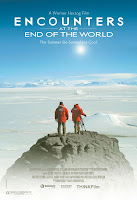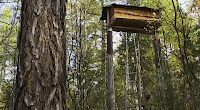Director:
Werner Herzog
Cinematographer:
Peter Zeitlinger

Dedicated to late Roger Ebert, Encounters at the End of the World is
another avant-garde documentary piece by Hergoz. Along with his
cameraman (Zeitlinger), this time he ventures to south-most point of the
planet—South Pole, Antarctica.
Ebert is clearly all enamored by the film, praising it highly: http://www.rogerebert.com/reviews/encounters-at-the-end-of-the-world-2008, and rightly so.
Hergoz's largely extempore interviews with scientist and travelers in various Antarctican base camps form the base material of the film. He eventually uses these casual interactions to explicate an underlying script for the film.
The footage beautifully captures the exotic Antarctica—loony penguins running wild, astounding seal-calls, luminescent jelly fish, under-surface tunnel leading right below the South Pole—leaving you simply bewitched. Mesmerizing underwater footage gives you a feel of the nether regions. Personally, I would have preferred the dead-silence of the sea bottom. However, realizing that the silent period would be little too long, Hergoz substituted it with cathedral-like music.
Making this film seem so natural was no mean feat, and wouldn’t have been possible for any other, even capable, director. Due to his reputation, Hergoz was allowed exclusive access to some publicly inaccessible areas and personnel. An excerpt from film's Wikipedia page:
“The film was shot in Antarctica as part of the National Science Foundation's Antarctic Artists and Writers Program. The entire film crew consisted of Herzog, who recorded all production sound, and cinematographer Peter Zeitlinger. The two went to Antarctica without any opportunity to plan filming locations or interview subjects, and had only seven weeks to conceive and shoot their footage. Herzog often met his interview subjects only minutes before he began shooting them.
Filming in Antarctica is usually overseen by the National Science Foundation's media office, which approves and supervises all film productions. Because of Herzog's grant from the Artists and Writers Program, he was allowed to film with no minders or oversight from the NSF. This allowed them to film the "seal-bagging" footage, which is not typically deemed suitable for public release.”
Filming in Antarctica is usually overseen by the National Science Foundation's media office, which approves and supervises all film productions. Because of Herzog's grant from the Artists and Writers Program, he was allowed to film with no minders or oversight from the NSF. This allowed them to film the "seal-bagging" footage, which is not typically deemed suitable for public release.”
Of course, you can read more in the wiki-page itself: http://en.wikipedia.org/wiki/Encounters_at_the_End_of_the_World
Peter Zeitlinger's astonishing behind-the-lens work deserves a special mention here. As always, he measures up to the vision and eccentricities of Herzog every time—exploring ice caves forged by fumaroles (volcanic steam and gas) on the slope of an active volcano is the best example of it.
Through this film, Hergoz is basically asking a question about Earth and mankind's distant future.
Through this film, Hergoz is basically asking a question about Earth and mankind's distant future.
8.2/10




















